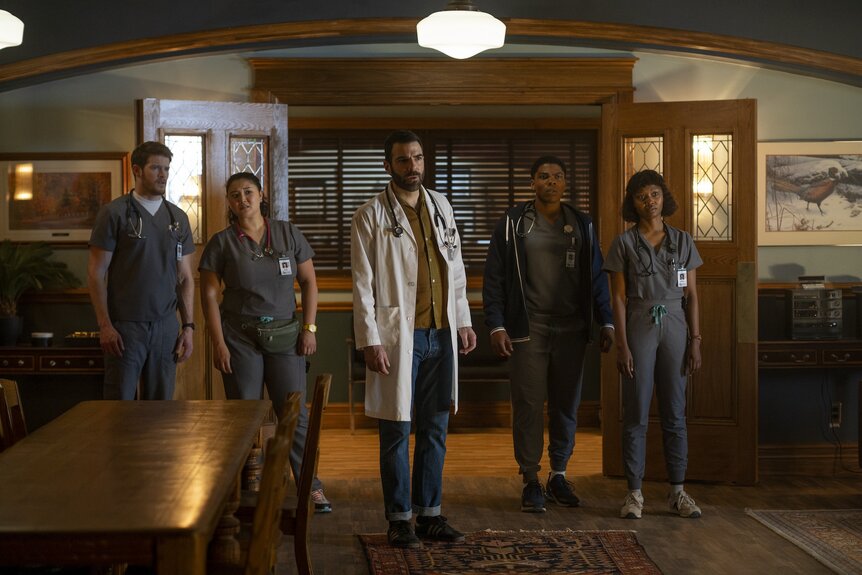Pseudocyesis (False Pregnancy) and Mass Hysteria: A Brilliant Minds Medical Mystery
Dr. Wolf discovers the true power of the mind in Episode 6 of Brilliant Minds.

Dr. Wolf (Zachary Quinto) and his interns at Bronx General meet a pregnant teenager during a routine ultrasound at the beginning of the sixth episode of Brilliant Minds, "The Girl Who Cried Pregnant." They don’t see a lot of prenatal ultrasounds in the neurological department, but this one reveals a startling problem with the pregnancy: there’s no baby in 17-year-old Sarah’s womb, and there never was.
RELATED: Brilliant Minds' Alex MacNicoll on Dr. Van's Mirror-Touch: "It Made Me a Better Person"
Sarah is experiencing a rare disorder known as pseudocyesis, commonly called false pregnancy. Here's what that means.
What is Pseudocyesis, also known as False Pregnancy?
Patients experiencing pseudocyesis exhibit the signs and symptoms usually associated with pregnancy, except for the all-important presence of a fetus. Put simply, a person with pseudocyesis so fully believes they are pregnant that the body behaves as if it’s true.
Symptoms include typical pregnancy symptoms, such as tender breasts, distended abdomen (a false baby bump), delayed menstruation, and even the sensation of a fetus moving in the womb. Usually, a false pregnancy is revealed when the patient receives a pregnancy test, ultrasounds, or other imaging. That’s part of the reason why pseudocyesis is more common in places where access to medical care is limited.
The precise causes of pseudocyesis aren’t wholly understood and likely vary from person to person, but it is usually associated with an external stressor like trauma (psychological or physical), hormone imbalance, or illness. It’s also often associated with a strong desire to become pregnant. In rare instances, a form of false pregnancy can even occur in biological males, usually when a partner or close relation is experiencing actual pregnancy symptoms. Such is the power of the mind!
In Episode 6 of Brilliant Minds, an already rare case of pseudocyesis is only the beginning of the medical mystery. Things get even weirder when the team discovers that Sarah’s entire friend group believes they’re pregnant. An investigation traces their symptoms back to a unique and bizarre set of circumstances.
RELATED: What Is Maple Syrup Urine Disease? A Brilliant Minds Medical Mystery
It begins with a tight-knit group of friends pretending to be schoolyard witches, recreating rituals they saw on TikTok; they hold hands and chant songs together, unwittingly placing themselves into a state of enhanced empathy. It turns out they've created a connection so deep that they can actually share desires, emotions, and sensations. When one of their number gets pulled out of school, courtesy of an actual pregnancy, the collective trauma (combined with a social-media-sourced magic spell) convinces them they’ve each immaculately conceived a baby. It’s a way of dealing with their trauma, by walking into adulthood together.
It might sound a little wacky, but this wouldn’t be the first time a group of people fell into a collective mass psychogenic illness (mass hysteria), or even the first time such an illness was facilitated by social media.
Examples of Mass Hysteria Through History
The events of Brilliant Minds Episode 6 are fictional, but mass psychogenic illness does happen and sometimes it’s way weirder than a group of friends thinking they’re pregnant.
Between the 14th and 17th centuries, thousands of people across Europe were swept up in a rash of chronic dancing. People gathered in the streets to boogie down until they collapsed from exhaustion. Some people reportedly even died, though those reports are difficult to substantiate centuries later.
In 1962, dozens of workers in a textile factory reported symptoms of numbness, nausea, dizziness, vomiting, and breaking out on the skin, accompanied by reports of an insect biting factory workers. Most of the victims worked on the same shift and were under excessive stress. Authorities were brought in to investigate the incident and no physical cause (including a malicious insect) was ever found.
In the 1970s, a handful of factories in Singapore played host to psychogenic illness. Workers were falling into a trance state, screaming, and reporting the presence of evil spirits. Dizziness and violence were also reported.
A decade later, people in the United States and around the world were swept up by the Satanic Panic (inspiration for Peacock’s Halloween horror series Hysteria!), an erroneous belief that devilish forces were working in secret to abuse children.
RELATED: The Real-World Satanic Panic that Inspired Peacock's Hysteria!
From the ‘80s into the mid-’90s, more than 12,000 cases of satanic ritual abuse were reported, none of which could be substantiated. At most, authorities found isolated instances of individuals utilizing satanic imagery in the commission of their crimes, but no coordinated effort by nefarious forces. The real culprits were likely the popular non-fiction book Michelle Remembers, which allegedly described memories of satanic ritual abuse recovered under hypnosis, and anxieties surrounding a recent cultural shift driving parents into the workforce and children into daycare.
When we're under a lot of stress, the mind is capable of some pretty unusual activity, from driving us collectively wild to forcing us to bust a move and even making you believe you're growing a person inside you.
Watch new episodes of Brilliant Minds when they premiere on Mondays on NBC at 10/9c. Episodes are available to stream on Peacock the next day.


















